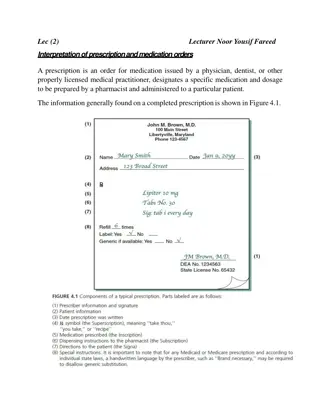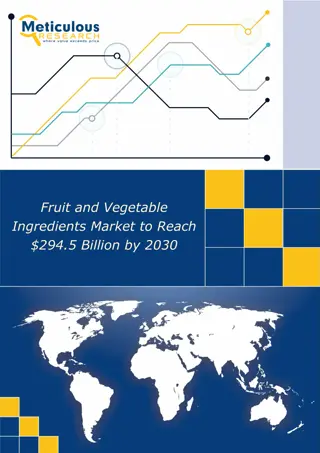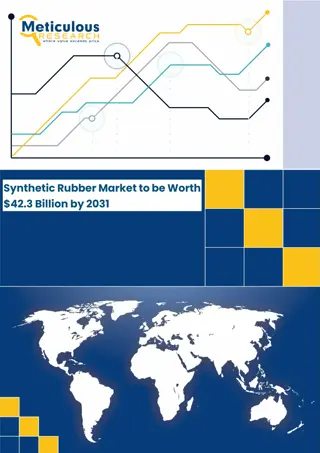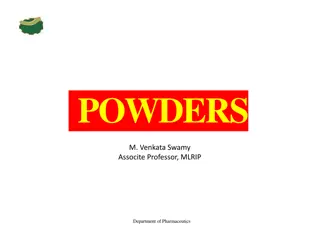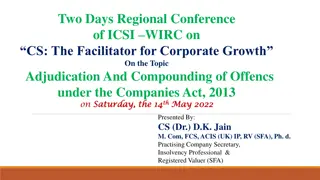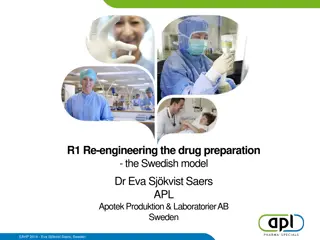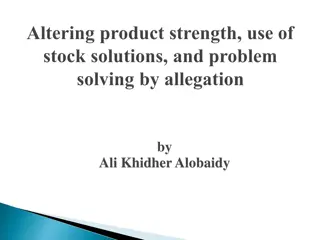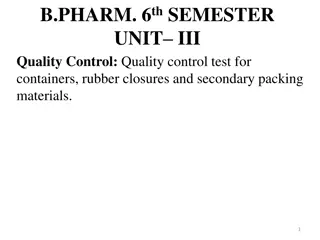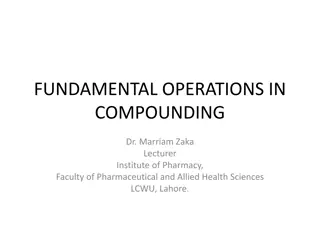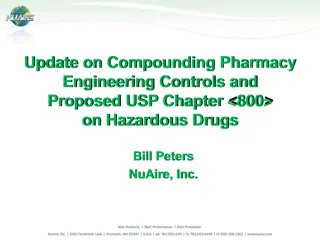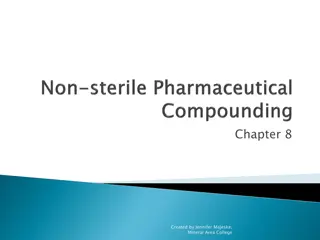Understanding Rubber Compounding Ingredients and Applications
Rubber compounding involves combining elastomers and various additives to achieve desired mechanical and chemical properties for different applications. This process ensures that rubber products meet specific requirements in terms of performance, cost-effectiveness, and processability. The course content covers the classification of compounding ingredients, functions of different additives, preparation of compounds, and applications in various rubber products such as tires, industrial goods, and consumer items.
Download Presentation

Please find below an Image/Link to download the presentation.
The content on the website is provided AS IS for your information and personal use only. It may not be sold, licensed, or shared on other websites without obtaining consent from the author. Download presentation by click this link. If you encounter any issues during the download, it is possible that the publisher has removed the file from their server.
E N D
Presentation Transcript
TECHNOLOGY OF ELASTOMERS Module I Compounding Ingredients Course Outcome : To Comprehend the preparation , properties and applications of compounding ingredients.
To Comprehend the preparation , properties and applications of compounding ingredients 1.1.1 Classify the compounding ingredients. 1.1.2 State the functions and characteristics of compounding ingredients with examples. 1.1.3 Explain different vulcanising agents and their roles in a recipe. 1.1.4 Describe the functions of activators and retarders. 1.1.5 State the function of accelerators and their classifications. 1.1.6 Explain the classification and role of antidegradents, processing aid, (plasticiser, softener, and extender). 1.1.7 Classify fillers with respect to colour, reinforcement, origin 1.1.8 Describe the preparation, characteristics and application of nonblack fillers like inorganic, fibrous, organic. resinous fillers. 1.1.9 Explain the classification and method of manufacturing carbon blacks. 1.1.10 State the properties of carbon black, and classification according to ASTM D 1765. 1.1.11 Describe the procedure for the determination of particle size and structure. 1.1.12 List the special purpose additives and their functions.
Rubber products are divided into Tyres Industrial goods (motor vehicle, rail road transportation, construction etc.) Consumer goods ( footwear, mats, inner tubes, O rings etc.)
Rubber Compounding Compound refers to a specific blend of ingredients used in the manufacturing of products in order to achieve a definite set of mechanical properties. Rubber Compounding science of selecting and combining elastomers and additives to obtain the desired properties (physical as well as chemical) for a finished product. It is through compounding that the specific rubber is designed to satisfy a given application in terms of properties, cost, and processability.
Classification of Compounding Ingredients Elastomers Vulcanizing Agents (curatives) Accelerators Activators and Retarders Antidegradants (Anti-oxidants, Antiozonants, Protective waxes ) Processing aids (Peptizers, Lubricants, Release Agents) Fillers (carbon black, non-black materials) Plasticizers, Softeners and Tackifiers Colour pigments Special Purpose Materials (Blowing Agents, Deodorants, etc.)
Elastomers/ Rubber Elastomers/ Rubber Single elastomer / blend of two or more different rubbers. Elastomers can be general purpose or special purpose synthetic rubbers. General purpose rubbers Used in the production of articles in which the basic property of vulcanized rubbers, i. e high elasticity at ordinary temperatures is desirable Example, tires, conveyer belts, and footwear. Special purpose rubbers Used in producing articles that should be resistant to the action of solvents, oils, oxygen etc. i. e , able to retain high elastic properties over a broad range of temperatures.
General Purpose Rubbers Special Purpose Rubbers Natural Rubber (NR) Acrylonitrile butadiene rubber (NBR) Styrene butadiene rubber (SBR) Chloroprene Rubber (CR) Isoprene-isobutylene rubber (IIR) Chlorosulphonated Polyethylene ( CSM) Ethylene propylene diene monomer (EPDM) Silicone Rubber Synthetic Polyisoprene Polysulphide Rubbers Polybutadiene rubber (BR) Polymer Selection : Cost , Ease of mixing , Strength requirements , Modulus or stiffness requirement, Abrasion resistance requirement , Elongation requirement, Oil resistance requirement , Service temperature, Flammability , Chemical resistance
Vulcanizing Agents/Curatives Vulcanization Cross linking process in which individual molecules of rubber (polymer) are converted into a three dimensional network of interconnected (polymer) chains through chemical cross links Vulcanizing agents are necessary for the formation of crosslinks changes from the thermoplastic to the elastic state and rubber
History of Vulcanization Discovered in 1839 by the U.S inventor Charles Goodyear . Thomas Hancock , a scientist and engineer, was the first to patent vulcanization of rubber. Hancock awarded British patent in 1844. Goodyear received United nations patent also in 1844.
As long as the molecules are not tied to each other, they can move more or less freely, especially at higher temperatures. Plastic behaviour , exhibits flow characteristics By cross linking, rubber changes from thermoplastic to elastic state. As more crosslinks , vulcanizates becomes tighter and force necessary to produce a given deformation increases. Effect of vulcanization resistance etc.. Improved elasticity, tensile strength, hardness and weather
VULCANIZING AGENTS TYPE COMMON USE Sulphur or Sulphur bearing materials Organic Peroxides Natural Rubber, Isoprene, SBR, IIR, Poly Butadiene, EPDM, Nitrile Urethane, Silicone, Chlorinated Polyethylene, PVC/Nitrile Metal Oxide Polychloroprene, Chlorosulphonated Polyethylene, Polysulphide Acrylic, Fluorocarbon, Epichlorohydrin IIR Organic Amines Phenolic Resins
Sulphur Curing Used for curing of unsaturated elastomers
Rubber + Sulphur : Vulcanization time 8 hrs @ 141 C Organic Chemicals Vulcanization time 4 hrs @ 141 C metallic oxides Reduced to 30 minutes or lesser
Accelerators Sulphur exists as S8 ring and stable. Splitting sulphur ring needs considerable amount of activating energy. Process of activation occurs at higher temperature, promoted by organic substances called Accelerators An accelerator is usually a complex organic chemical which takes part in the vulcanization, thereby reducing the vulcanization time considerably Used to increase the speed of vulcanization.
Characteristics of an accelerator Should give flat cure Should provide scorch safety Should give good storage properties for the uncured compound Should give good physical properties to vulcanizates Delayed action Fast / Ultrafast Vulcanization rate Slow Medium
Activators Used to increase the efficiency of accelerators. Additives that activate sulphur cure and improve the efficiency of sulphur based cure systems. Commonly used - Zinc fatty acid ester which is often formed in-situ by reaction of fatty acid with zinc oxide. Fatty acids include stearic, lauric, palmitic, oleic and naphthenic acid. Fatty acid solubilizes the zinc and forms the actual catalyst. Zinc oxide can also act as a filler or white colorant in rubber products whereas the fatty acid improves filler incorporation and dispersion.
Classification of accelerators An accelerator is a complex organic chemical which takes part in the vulcanization, thereby reducing the vulcanization time considerably. Vulcanization accelerators classified as (based on their role in a given compound) Primary Accelerators Based on the vulcanization rate, classified into Secondary Accelerators Slow Accelerators Medium Accelerators Ultrafast Accelerators Delayed Action Accelerators Cross-link density and the cure speed depend on the type and dosage of accelerator used.
Primary accelerators provides long scorch time medium to fast cure good modulus (crosslink density) development. Dosage : 0.5 to 1.5 phr Examples : Sulphenamides and thiazoles. Secondary accelerators (used at much lower concentration) activates primary accelerators increases speed of vulcanization (increases cross links density) reduces scorch safety Dosage : 10-40% of primary accelerator (0.05 to 0.5 phr) Examples : dithiocarbamate, thiurams, guanidines
Thiazole Accelerators Medium fast accelerator Improved scorch safety Need higher temperature for vulcanization Examples : Dibenzene thiazyl disulphide (MBTS) 2-mercaptobenzothiazole (MBT) Zinc salt of mercaptobenzothiazole (ZMBT) MBT & ZMBT fast onset of vulcanization and lower processing safety Zinc salt (ZMBT) is used mainly with latex compounds MBTS provides safe processing
Sulphenamide accelerators Primary accelerator Delayed action accelerator as well as provides faster cure rate Can be boosted with small amounts of secondary accelerators like DPG, TMTD, TMTM etc. Provide good resistance to reversion. Examples Cyclohexyl benzothiazole/ thiazyl sulphenamide (CBS) Tertiary butyl benzothiazyl sulphenamide (TBBS) Dicyclo hexyl benzothiazyl sulphenamide (DCBS)
Thiuram accelerators Fast accelerator Faster curing rate, higher crosslink density Lower processing safety As secondary accelerator with dithiocarbamates, sulfenamides, or thiazole. As primary accelerator for sulphur cured low unsaturated rubbers Examples Tetramethyl thiuram disulfide (TMTD) Tetraethyl thiuram disulfide (TETD) Tetramethyl thiuram monosulfide (TMTM)
Dithiocarbamate Accelerators Ultra fast accelerator Mostly used in latex based compounds Functions both as primary as well as secondary accelerators low scorch safety faster cure rate higher crosslink density Vulcanized in a short time at low temperature (115 - 120 C) Examples Zinc diethyl dithiocarbamate (ZDEC) N-dimethyl dithiocarbamate (ZDMC) Zinc N-dibutyl dithiocarbamate (ZDBC)
Guanidines Examples : (DOTG). Slow cure rate and require the use of zinc oxide for activation Used for thick walled rubber products As secondary accelerators in combination with thiazoles Results in relative high crosslink density and good physical-mechanical properties such as high modulus and good compression set. Cause a brown discoloration, not suitable for light coloured products diphenyl guanidine (DPG) and N, N -diorthotolyl guanidine
Xanthates Ultra fast primary vulcanization accelerators Used for vulcanization of rubber latex and rubber in solution. Employed for low vulcanization temperature applications. Examples : Zinc (ZIX) and sodium isopropyl xanthate (NaIX). The later is water soluble, and ideal for latex vulcanization.
Thioureas Ultrafast primary or secondary accelerators. Examples Ethylene thiourea (ETU) dipentamethylene thiourea (DPTU) dibutyl thiourea (DBTU) Mainly used for the vulcanization of chloroprene rubbers.
Sulphur donors Capable of providing active sulphur during the vulcanization process thereby generating sulphidic cross links. Classified as those that are applied as a direct substitute for free sulphur and those that act simultaneously as vulcanization accelerators. Examples Caprolactam disulphide( CLD) Tetramethylthiuram disulphide (TMTD).
Retarders/ Prevulcanization inhibitors (PVI) Reduce accelerator activity during processing and storage. Prevent scorch during processing and prevulcanization during storage. They should either decompose or not interfere with the accelerator during normal curing at elevated temperatures. Acts as organic acids that function by lowering the pH of the mixture, thus retarding vulcanization. Examples Benzoic acid phthalic anhydride (up to 2 phr) maleic acid Cyclohexylthiophthalimide (CTP)
Non- Sulphur Vulcanization Peroxide Curing Metal oxide curing Resin curing Radiation curing
Peroxide Curing Curing saturated as well as unsaturated rubbers Used for curing EPDM, Chlorinated PE, Hypalon, Silicone rubbers. Examples - diacyl peroxides, dialkyl or diaralkyl peroxides, peresters and peroxyketals Curing takes place by thermal decomposition into oxy and peroxy free radicals and abstracting hydrogen atoms from the saturated elastomer to generate elastomer chain radicals. Cannot be used with butyl rubber because they cause chain scission and depolymerisation.
Metal Oxide Curing Used for curing as polychloroprene rubber (CR), halogenated butyl rubber, and chlorosulfonated polyethylene rubber. Curing agents - ZnO, MgO and Pb2O3 Mixtures of (ZnO and MgO) are used because ZnO alone is too scorchy , MgO alone is inefficient. Zinc oxide and lead oxide combination for improved water resistance.
Resin Curing Used for curing unsaturated rubbers, used with butyl rubber for high temperature applications. Certain di-functional compounds form crosslinks with elastomers by reacting with two polymer molecules to form a bridge. Resin cures are slower than accelerated sulphur cures and high temperatures are required, activated only by zinc oxide and halogen atoms (SnCl2 ). Resin has got adhering capacity, low molecular weight resin molecules diffuse into rubber thereby stiffen the rubber. Examples : Epoxy resins - NBR Quinone di-oximes and phenolic resins -butyl rubbers dithiols and diamines - fluorocarbon rubbers.
Radiation Induced Crosslinking Physically induced chemical reaction, which is easier and preferable for continuous curing. Includes electron beam crosslinking, photo-crosslinking, microwave crosslinking, ultrasonic crosslinking etc. Upon irradiation free radicals are formed in rubber molecules. Free radicals can combine to form crosslinks as in the case with peroxide crosslinking. In radiation crosslinking of rubbers, kneaded rubber is placed in an aluminium die and is pressed at 100-200 C for 5-10 minutes, allowed to cool under pressure and then exposed to radiation. Use of sensitizers can reduce the required dose and radiation time. Examples : Halogen compounds, nitrous oxide, sulphur monochloride and bases like amine, ammonia etc.
Antidegradants Degradation of Rubber Chain scission resulting in shorter chains and lower molecular weight ( NR & IIR softened stock showing tackiness ). Cross-linking resulting in three dimensional structures and higher molecular weight (SBR & NBR brittle stocks with poor flexibility and elongation) Chemical alteration Factors affecting degradation External factors oxygen, ozone, pro-oxidants, heat, light and fatigue Internal factors type of rubber, degree and type of vulcanization accelerators used, compounding ingredients and protective agents
Factors contributing to degradation Oxygen Mode of attack oxygen on unvulcanised rubber is different from vulcanized rubber. Unvulcanised stock initial induction period followed by rapid up-take of oxygen Vulcanised stock- no induction period Cu , Mn, Co, Ni and Iron ( increase the rate of oxygen attack) in NR ; Iron SBR Cu salts increases rate of chain scission ; Co salts increases rate of crosslinking Pro-oxidants Ozone concentration in atmosphere 0-6 ppm Ozone reacts with unsaturated rubber forming ozonides which decompose into products of lower molecular weight Ozone degradation occurs in two ways In rubber under stress cracks appear perpendicular to stress In unstressed rubber , silvery film appears on the surface of the article in hot humid weather Ozone Heat Combination of crosslinking and increase in rate of oxidation Fatigue Weakening of rubber due to continuously repeated distortions Cause of failure due to : Stress breaking of chain or cross links Oxidation accelerated by heat build p in flexing Light and weathering ( UV radiation) Light promotes action of oxygen at the surface producing a film of oxidised rubber Oxidised film reacts with water vapour and heat to produce crazing (fine cracks), exposing filler by washing of the oxidised layer Exposed filler can be rubbed off , a condition known a s Chalking.
Antidegradants are used to protect the rubber from degradation so that a longer service life is obtained. Includes antioxidants and antiozonants. Selection of antidegradants is based on Type of protection desired Environment in which the product is exposed. Chemical activity Persistence (volatility and extractability) Nature of end use Discoloration and staining Toxicology Cost Antidegradants classified into Amines - strong antidegradants , discolour and staining in nature Phenolic compounds less effective, non discolouring and non-staining
Chemical Name Oxygen Heat Flexing Pro-oxidant Ozone N- phenyl-N-isopropyl P- phenylene diamine Good Vey good Excellent Excellent Excellent N- (1,3-dimethylbutyl) N-phenylenediamine Good Vey good Excellent Excellent Excellent Phenyl- -naphthylamine Good Good Good Moderate -- Substituted phenol Poor Poor Moderate No No Blend of arylamines and diphenyl-p- phenylenediamine Good Good Excellent Poor Fair
FILLERS Fillers are materials used to Extent the range of physical properties Reduce compound cost Modify the processing properties Influence the chemical resistance of the compound The effect of a filler on rubber depends on- Structure Particle size Surface area Geometrical characteristics
Diluents or extenders Non-reinforcing filler/ inactive fillers Primarily to occupy space and used to lower the formulation cost. Particle size : 1,000 and 10,000 nm (1 to 10 m) Functional or reinforcing fillers Functional or reinforcing fillers/active fillers Particle size range : 10 to 100 nm (0.01 to 01 m) Improve the modulus and failure properties (tensile strength, tear resistance and abrasion resistance) of the final vulcanizates. Semi- reinforcing fillers Moderately improve the tensile strength and tear strength, but does not improve the abrasion resistance Particle size range : 100 to 1000 nm (0.1 to 1 m)
Reinforcing Type` Carbon Black (listed in order of increasing particle size) N220 (ISAF) N330(HAF) N550 (FEF) N762 (SRF-LM) N990 (MT) Silica Zinc Oxide Magnesium Carbonate Aluminium Silicate Sodium Aluminosilicate Magnesium Silicate Calcium Carbonate Barium Sulfate Aluminium Trihydrate Non-black Extending Type
Reinforcement by fillers Reinforcement by fillers Condition for filler reinforcement is the interaction between the filler particles and the polymer. Interactions can be strong, for example in the case of covalent bonds between functional groups on the filler surface and the polymer, or weak as in the case of physical attractive forces. When carbon black is blended with a polymer, the level of physical interaction is high. But interaction between silica particles and the polymer is very weak, and only by the use of a coupling agent a bond is formed between the filler and the polymer.
Factors influencing elastomer reinforcement Factors influencing elastomer reinforcement There is an optimum loading of filler indicating that there are two opposing factors in action when a reinforcing fillers such as carbon black is added. First, there is an increase of modulus and TS, which is dependent on the particle size of filler. ( smaller PS, greater SA, interaction between polymer and filler surface) Secondly, the reduction in properties at higher loading is a simple dilution effect, generally to all fillers, due to a diminishing volume fraction of polymer in composite. If there is not enough rubber matrix to hold the filler particles together, strength rapidly approaches to zero.
Carbon black Carbon blacks are produced by converting either liquid or gaseous hydrocarbons to elemental carbon and hydrogen by partial combustion or thermal decomposition. Chemical process Manufacturing method Raw materials Thermal oxidative decomposition Furnace black process Aromatic oils on coal tar basis or mineral oil, natural gas Lamp black process Aromatic oils on coal tar basis or mineral oil Channel Black process Coal tar distillates Thermal decomposition Thermal black process Natural gas or mineral oils Acetylene black process Acetylene
Depending on the process adopted for the preparation, carbon blacks are classified as Furnace blacks- produced by incomplete combustion of natural gas or heavy aromatic residue oils from the petroleum industries (particle size 20 nm 80 nm). Thermal blacks decomposition of natural gas or oil at 1300 oC in the absence of free air (particle size 20 nm 80nm). Acetylene black is a thermal type. Decomposition of acetylene gas is exothermic, so heat is supplied only to start the reaction. Channel blacks - produced by feeding the natural gas or oil into thousands of small burner trips where the small flames impinge on to a large rotating drum Lamp black - made by burning oil and allowing the black formed to settle out by gravity in series of chambers.
Properties of Carbon black Composed from three colloidal particles morphological forms existing in rubber compounding includes (primary particle, aggregate, and agglomerate). Sizes of these morphological forms have the following order: particle < aggregate < agglomerate. 85 500 nm 15 300 nm 1 100 m
Important properties of carbon black Particle size Structure Physical nature of the surface Chemical nature of the surface Particle porosity
Particle size The particles of carbon blacks are not discrete but are fused clusters of individual particles. It is the fundamental property that has a significant effect on rubber properties. Finer particles lead to increased reinforcement, increased abrasion resistance, and improved tensile strength. Transmission electron microscope and surface area by adsorption methods are used to determine particle size .
Determination of particle size Surface area measurements give an indirect characterization of carbon black particle size. Surface area determination using Iodine adsorption (expressed in mg/g of carbon) measures the amount of iodine which can be adsorbed on the surface of a given mass of carbon black. BET (Brunauer, Emmett and Teller ) method / Nitrogen adsorption surface area is a measurement of the amount of nitrogen which can be adsorbed on a given mass of carbon black. Iodine and nitrogen molecules are sufficiently small to be adsorbed in the narrow slits or pores which can be formed in CB by oxidation at higher temperatures. Rubber molecules are much bigger than these imperfections, so the extra surface area is not available for rubber- CB interactions. Overcomed using cetyl trimethyl ammonium bromide molecule (CTAB) .CTAB (m2/g) gives best correlation with primary particle size.
Structure Carbon blacks do not exist as primary particles. Primary particles fuse to form aggregates, which may contain a large number of particles. The shape and degree of branching of the aggregates is referred to as structure.


